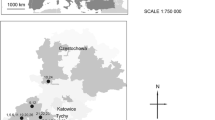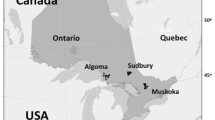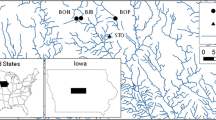Abstract
Fifty-one amphibian breeding sites in northern Wisconsin were sampled in two surveys, in 1986 and 1987, to determine the chemical conditions and amphibian inhabitants present. All twenty-one ponds in 1986 and twenty-eight in 1987 were mildly acidic and sensitive to acidification. The pH levels encountered were generally not toxic to the resident amphibians, and may have been related to levels of phenolics in some cases. Soil type and forest canopy coverage appeared to influence the chemistry of these ponds and a direct relationship of amphibian species richness with pond size was found. Only larger ponds were long-lived enough for metamorphosis of amphibian larvae, suggesting an importance for recruitment. They were also the most sensitive ponds and the only ones to enter the chronically toxic pH range for ambystomatid salamanders, possibly placing them at risk to future acid inputs.
Similar content being viewed by others
References
Albers, P. H. & R. M. Prouty, 1987. Survival of spotted salamander eggs in temporary ponds of coastal Maryland. Envir. Pollut. 46: 45–61.
American Public Health Association, American Water Works Association, and the Water Pollution Control Federation, 1981. Standard Methods for the examination of water and wastewater. APHA, Washington, D.C., 1134 pp.
Clark, K. L., 1986a. Distributions of anuran populations in central Ontario relative to habitat acidity. Wat. Air Soil Pollut. 30: 727–734.
Clark, K. L., 1986b. Responses of spotted salamander, Ambystoma maculatum, populations in Central Ontario to habitat acidity. Can. Field Nat. 100: 463–469.
Cole, J. & S. G. Fisher, 1979. Nutrient budgets of a temporary pond ecosystem. Hydrobiologia 63: 213–222.
Conner, E. F., 1979. The statistics and biology of the species-area relationship. Am. Nat. 113: 791–833.
Dale, J. M., B. Freedman & J. Kerekes, 1985. Acidity and associated water chemistry of amphibian habitats in Nova Scotia. Can. J. Zool. 63: 97–105.
Fay Baird, S., D. C. Buso & J. W. Hornbeck, 1987. Acid pulses from snowmelt at acidic Cone Pond, New Hampshire. Wat. Air Soil Pollut. 34: 325–338.
Freda, J., 1986. The influence of acidic pond water on amphibians: a review. Wat. Air Soil Pollut. 30: 439–450.
Freda, J. & W. A. Dunson, 1986. Effects of low pH and other chemical variables on the larval distribution of amphibians. Copeia 1986: 454–466.
Freda, J. & W. A. Dunson, 1985. The effect of acidic precipitation on amphibians breeding in temporary ponds in Pennsylvania. U.S. Fish and Wildlife Service, Eastern Energy and Land Use Team. Biol. Rep. 80 (40.22). 85 pp.
Galloway, J. N., B. J. Cosby & G. E. Likens, 1979. Acid precipitation: measurement of pH and acidity. Limnol. Oceanogr. 24: 1161–1165.
Hole, F. D., 1980. Soil guide for Wisconsin land lookers. Wisconsin Geological and Natural History Survey, Bull. 88, University of Wisconsin - Madison, 64 pp.
Johnson, H. M., G. E. Likens, M. C. Feller & C. T. Driscoll, 1984. Acid rain and soil chemistry. Science 225: 1424–1425.
Ling, R. W., J. P. VanAmberg & J. K. Werner, 1986. Pond acidity and its relationship to larval development of Ambystoma maculatum and Rana sylvatica in upper Michigan. J. Herpetol. 20: 230–236.
O'Neill Morin, J. & K. D. Kimball, 1983. Relationship of macrophyte-mediated changes in the water column to periphyton composition and abundance. Freshwat. Biol. 13: 403–414.
Pough, F. H. & R. E. Wilson, 1977. Acid precipitation and reproductive success of Ambystoma salamanders. Wat. Air Soil Pollut. 7: 307–316.
Pylypec, B. & R. E. Redman, 1984. Acid buffering capacity of foliage from boreal forest species. Can. J. Bot. 62: 2650–2653.
Rahel, F. J. & J. J. Magnuson,1983. Low pH and the absence of fish species in naturally acidic Wisconsin lakes: Inferences for cultural acidification. Can. J. Fish. aquat. Sci. 40: 3–9.
Smith, D. C., 1983. Factors controlling tadpole populations of the chorus frog (Pseudacris triseriata) in Isle Royale, Michigan. Ecology 64: 501–510.
Turk, J., 1986. Precision of a field method for determination of pH in dilute lakes. Wat. Air Soil Pollut. 27: 237–242.
Wiener, J. G. & W. R. Hanneman, 1982. Growth and condition of bluegills in Wisconsin lakes: Effects of population density and lake pH. Trans. am. Fish. Soc. 111: 761–767.
Wilbur, H. M., 1984. Complex life cycles and community organization in amphibians. In P. W. Price, C. N. Slobodchikoff & W. S. Gaud, A new ecology: novel approaches to interactive systems. John Wiley and Sons, New York, 515 pp.
Wisniewski, J. & J. D. Kinsman, 1988. pH and hydrogen ion deposition patterns in precipitation for continental United States and Canada. Wat. Air Soil Pollut. 38: 1–17.
Author information
Authors and Affiliations
Rights and permissions
About this article
Cite this article
Kutka, F.J., Bachmann, M.D. Acid sensitivity and water chemistry correlates of amphibian breeding ponds in northern Wisconsin, USA. Hydrobiologia 208, 153–160 (1990). https://doi.org/10.1007/BF00007781
Received:
Revised:
Accepted:
Issue Date:
DOI: https://doi.org/10.1007/BF00007781




